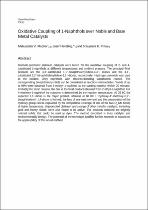JavaScript is disabled for your browser. Some features of this site may not work without it.
- ResearchSpace
- →
- Research Publications/Outputs
- →
- Journal Articles
- →
- View Item
| dc.contributor.author |
Maphoru, MV

|
|
| dc.contributor.author |
Heveling, J

|
|
| dc.contributor.author |
Kesavan Pillai, Sreejarani

|
|
| dc.date.accessioned | 2014-08-15T13:03:13Z | |
| dc.date.available | 2014-08-15T13:03:13Z | |
| dc.date.issued | 2014-01 | |
| dc.identifier.citation | Maphoru, M.V., Heveling, J. and Kesavan Pillai, S. 2014. Oxidative coupling of 1-naphthols over noble and base metal catalysts. ChemPlusChem, vol. 79(1), pp 99-106 | en_US |
| dc.identifier.issn | 2192-6506 | |
| dc.identifier.uri | http://onlinelibrary.wiley.com/doi/10.1002/cplu.201300307/pdf | |
| dc.identifier.uri | http://hdl.handle.net/10204/7595 | |
| dc.description | Copyright: 2014 Wiley. This is an ABSTRACT ONLY. The definitive version is published in ChemPlusChem, vol. 79(1), pp 99-106 | en_US |
| dc.description.abstract | Bismuth-promoted platinum catalysts were tested for the oxidative coupling of 2- and 4-substituted 1-naphthols at different temperatures and ambient pressure. The principal final products are the 3,3'-substituted 1,1'-binaphthalenylidene-4,4'-diones and the 4,4'-substituted 2,2'-binaphthalenylidene-1,1'-diones, respectively. Hydrogen peroxide was used as the oxidant. Only naphthols with electron-donating substituents reacted. The corresponding binaphthalenyl diols can be considered as reaction intermediates. Yields of up to 99% were obtained from 2-methyl-1-naphthol as the starting material within 20 minutes. Probably for steric reasons, the diol is the final product obtained from 2-ethyl-1-naphthol. For 4-methoxy-1-naphthol the outcome is determined by the reaction temperature. At 25°C the expected 1,1'-dione is the major product, whereas at 60°C 1'-hydroxy-4'-methoxy-2,2'-binaphthalenyl-1,4-dione is formed; the loss of one methoxy unit and the preservation of the hydroxy group can be explained by the competitive cleavage of one of the two O[BOND]Me bonds at higher temperature. Unpromoted platinum and a range of other metallic catalysts, including gold and Raney nickel, were also found to be active. The products obtained are brightly colored solids that could be used as dyes. The method described is truly catalytic and environmentally benign. The potential of the technique justifies further research to expand on the applicability of this novel method. | en_US |
| dc.language.iso | en | en_US |
| dc.publisher | Wiley | en_US |
| dc.relation.ispartofseries | Workflow;12690 | |
| dc.subject | Bismuth-promoted platinum catalysts | en_US |
| dc.subject | Metal catalysts | en_US |
| dc.subject | Oxidation | en_US |
| dc.title | Oxidative coupling of 1-naphthols over noble and base metal catalysts | en_US |
| dc.type | Article | en_US |
| dc.identifier.apacitation | Maphoru, M., Heveling, J., & Kesavan Pillai, S. (2014). Oxidative coupling of 1-naphthols over noble and base metal catalysts. http://hdl.handle.net/10204/7595 | en_ZA |
| dc.identifier.chicagocitation | Maphoru, MV, J Heveling, and Sreejarani Kesavan Pillai "Oxidative coupling of 1-naphthols over noble and base metal catalysts." (2014) http://hdl.handle.net/10204/7595 | en_ZA |
| dc.identifier.vancouvercitation | Maphoru M, Heveling J, Kesavan Pillai S. Oxidative coupling of 1-naphthols over noble and base metal catalysts. 2014; http://hdl.handle.net/10204/7595. | en_ZA |
| dc.identifier.ris | TY - Article AU - Maphoru, MV AU - Heveling, J AU - Kesavan Pillai, Sreejarani AB - Bismuth-promoted platinum catalysts were tested for the oxidative coupling of 2- and 4-substituted 1-naphthols at different temperatures and ambient pressure. The principal final products are the 3,3'-substituted 1,1'-binaphthalenylidene-4,4'-diones and the 4,4'-substituted 2,2'-binaphthalenylidene-1,1'-diones, respectively. Hydrogen peroxide was used as the oxidant. Only naphthols with electron-donating substituents reacted. The corresponding binaphthalenyl diols can be considered as reaction intermediates. Yields of up to 99% were obtained from 2-methyl-1-naphthol as the starting material within 20 minutes. Probably for steric reasons, the diol is the final product obtained from 2-ethyl-1-naphthol. For 4-methoxy-1-naphthol the outcome is determined by the reaction temperature. At 25°C the expected 1,1'-dione is the major product, whereas at 60°C 1'-hydroxy-4'-methoxy-2,2'-binaphthalenyl-1,4-dione is formed; the loss of one methoxy unit and the preservation of the hydroxy group can be explained by the competitive cleavage of one of the two O[BOND]Me bonds at higher temperature. Unpromoted platinum and a range of other metallic catalysts, including gold and Raney nickel, were also found to be active. The products obtained are brightly colored solids that could be used as dyes. The method described is truly catalytic and environmentally benign. The potential of the technique justifies further research to expand on the applicability of this novel method. DA - 2014-01 DB - ResearchSpace DP - CSIR KW - Bismuth-promoted platinum catalysts KW - Metal catalysts KW - Oxidation LK - https://researchspace.csir.co.za PY - 2014 SM - 2192-6506 T1 - Oxidative coupling of 1-naphthols over noble and base metal catalysts TI - Oxidative coupling of 1-naphthols over noble and base metal catalysts UR - http://hdl.handle.net/10204/7595 ER - | en_ZA |






